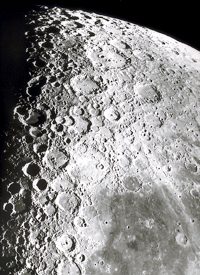
NASA’s Moon Mineralogy Mapper (M3) has verified an discovery important for the future of manned space flight: there is water on the Moon. According to a NASA news release:
NASA scientists have discovered water molecules in the polar regions of the Moon. Instruments aboard three separate spacecraft revealed water molecules in amounts that are greater than predicted, but still relatively small. Hydroxyl, a molecule consisting of one oxygen atom and one hydrogen atom, also was found in the lunar soil. The findings were published in Thursday’s edition of the journal Science.
The observations were made by NASA’s Moon Mineralogy Mapper, or M3 ("M-cubed"), aboard the Indian Space Research Organization’s Chandrayaan-1 spacecraft. NASA’s Cassini spacecraft and NASA’s Epoxi spacecraft have confirmed the find….
For additional confirmation, scientists turned to the Epoxi mission while it was flying past the Moon in June 2009 on its way to a November 2010 encounter with comet Hartley 2. The spacecraft not only confirmed the VIMS and M3 findings, but also expanded on them.
"With our extended spectral range and views over the north pole, we were able to explore the distribution of both water and hydroxyl as a function of temperature, latitude, composition, and time of day," said Jessica Sunshine of the University of Maryland. Sunshine is Epoxi’s deputy principal investigator and a scientist on the M3 team. "Our analysis unequivocally confirms the presence of these molecules on the Moon’s surface and reveals that the entire surface appears to be hydrated during at least some portion of the lunar day."
From the perspective of a water-rich world such as Earth, water is still a vanishingly-rare commodity on the Moon; preliminary estimates are that water may make up 1,000 parts-per-million in the lunar soil. According to Roger Clark, a U.S. Geological Survey scientist who is a member of the M3 team: "To put that into perspective, if you harvested one ton of the top layer of the Moon’s surface, you could get as much as 32 ounces of water." This means that the wettest places on the Moon are astoundingly dry; by way of comparison, if there were concrete on the Moon, explorers would want to mine it for the water.
Nevertheless, the M3 discovery is a significant breakthrough, providing an opportunity to learn more about the Moon and its relationship to the Earth and the rest of the solar system. Scientists will continue to debate how the water got on the Moon in the first place. The claim of the Epoxi’s deputy principal investigator that “the entire surface appears to be hydrated” for at least part of the lunar day (over 27 Earth days) means that the Moon may be significantly “wetter” than some scientists had previously expected.
In addition, as the United States considers a return to the Moon 40 years after the Apollo program, the discovery of water is significant for any prospects — governmental or commercial —for establishing a moon base. Developing a process for extracting water from the lunar soil promises to be far cheaper in the long run than hauling water from Earth, and water can be electrolyzed into oxygen and hydrogen, providing atmosphere for future habitats and fuel for spacecraft. As always, the question remains whether mankind will make use of available resources.



